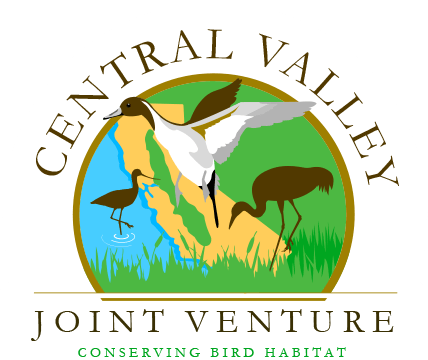Floodplain Restoration for Public Safety and Bird Habitat
Dos Rios State Park, in the San Joaquin Valley, is the largest public-private floodplain restoration project in California. Led by CVJV partner group River Partners, this green infrastructure project reduces flood risk for downstream communities, improves air and water quality, and provides outdoor recreation opportunities, all while restoring habitat for birds, salmon and other wildlife, including threatened and endangered species.
Dos Rios State Park exemplifies the win-win approach CVJV takes, working with public agencies, non-profit organizations, private landowners and others toward common goals. Learn more at bit.ly/River-Partners-Dos-Rios.
Photos: 1. Volunteers learn how to plant native vegetation to help restore Dos Rios. River Partners; 2. Dos Rios State Park, with farm fields and replanted wildlife habitat. River Partners; 3. Threatened Least Bell’s Vireos are breeding at Dos Rios. Robert A. Hamilton; 4. Least Bell’s Vireo nest. Julie Rentner. 5. Dos Rios provides habitat for imperiled monarch butterflies and other beneficial insects. River Partners.
San Joaquin Planning Region
The San Joaquin Planning region encompasses the San Joaquin Basin which consists of approximately 2,845,000 acres extending 80 miles from the Stanislaus River in the North to the San Joaquin River in the south. The Coast Range borders the basin on the west and foothills of the Sierra Nevada on the east. Where it turns north, the San Joaquin river bisects the basin from south to north, with major tributaries, including the Merced, Tuolumne and Stanislaus Rivers, flowing from the east. While agriculture is the predominant land use in the basin, wildlife friendly food crops are limited with orchards and row crops primarily grown. The region contains several National Wildlife Refuges and State Wildlife Areas as well as extensive private wetlands located in the Grasslands Ecological Area. The majority of the private wetlands are permanently protected with federal and state conservation easements and most wetlands in this area have reliable water supplies. This area represents the largest block of contiguous wetlands in the Central Valley and provides significant habitat for wintering and breeding waterfowl, shorebirds and other waterbirds. In addition, considerable remnant and restored riparian habitat is protected along the San Joaquin River and tributaries by National Wildlife Refuges, State Parks and privately-owned conservation lands. These lands provide some of the most important habitat for riparian landbirds in the Central Valley.
